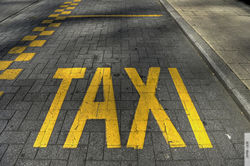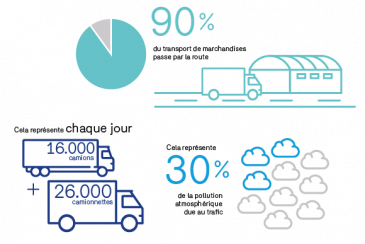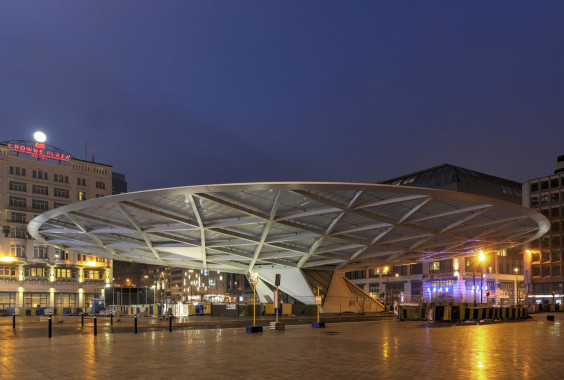A theme-based interpretation: the roadmaps
The Brussels-Capital Region currently has a series of themed strategic plans: the "Bicycle" Plan, the "Pedestrian" Plan, the Road Safety Action Plan, the Strategic Plan for transport of goods, etc. These tools are currently being updated to ensure that they are fully in line with the ambitions of the new Good Move 2020-2030 plan in terms of mobility and road safety. These new documents will be called "roadmaps" and will provide a themed breakdown of the approach and cross-disciplinary focuses of the Good Move plan. These roadmaps are an additional tool for monitoring the implementation of the Region's mobility policy.
"Pedestrian" roadmap
In order to promote walking, the Brussels-Capital Region currently has a "pedestrian" plan; a "pedestrian" roadmap will follow shortly.
With the "pedestrian" plan, the Brussels-Capital Region intends to implement a detailed and comprehensive policy aimed at making the city pedestrian-friendly. Emphasis is placed on the promotion of walking for the daily commute. This creates tangible levers in terms of traffic and mobility, land use and urban planning, standards and organisation, image and promotion. This plan must above all be a lever and source of inspiration to initiate a culture shift. Catering for the needs of pedestrians must become an automatic reaction for all stakeholders. Download the Pedestrian plan.
Brussels Mobility, working with the Ascaudit and Timenco consultancies, has drawn up accessibility plans for roads and public spaces in partnership with the 19 Brussels municipalities.
There are various technical guides to assist project managers in the development of public space. These publications help to promote walking in Brussels. Brussels Mobility also subsidises studies and analyses in the field of mobility and road safety.
Brussels Mobility also subsidises and is involved with other publications:
- le Guide de l’espace public bruxellois, ]pyblik[
- la brochure [ESPACE · PUBLIEK]
"Bicycle" roadmap
In order to promote cycling, the Brussels-Capital Region currently has a "bicycle" plan; a "bicycle" roadmap will follow shortly.
With the "bicycle" plan, the Brussels-Capital Region intends to consider and propose measures designed to encourage cycling in the city, in the context of a sustainable vision of the city. In a small and highly urbanised area such as that of the Brussels-Capital Region, cycling plays a fundamental role in this sustainable mobility policy: non-polluting, quiet, healthy, and above all tremendously effective for city travel.
More info:
The Brussels-Capital Region subsidises an audit of cycling policy, called BYPAD (BicYcle Policy AuDit). This is an instrument for evaluating the quality of the "cycling" policy in the capital, in consultation with local stakeholders (politicians, administrations and user organisations) and leading to the creation of an improvement plan.
Other initiatives helping to get people on bikes:
- Bike for Brussels, a site where you can find all the information related to cycling;
- A route planner, for online journey planning, using the network of regional cycle routes among other tools;
- bikenode.brussels, which can be used to plan an excursion within or outside Brussels through the node network
- CycloFix, which lists facilities such as water fountains, bike repair points, bike parking on a map.
Feuille de route "sécurité routière"
Afin de promouvoir la sécurité routière, la Région de Bruxelles-Capitale dispose actuellement d’un Plan d’action « sécurité routière », qui détaille les mesures qui doivent être prises pour l’ensemble de la Région bruxelloise. Une feuille de route « sécurité routière » lui succèdera prochainement.
Plus d'info : Sécurité routière
"Parking roadmap"
The Brussels-Capital Region currently has a "parking" plan; a "parking" roadmap will follow shortly.

The Regional Parking Policy Plan (RPPP) aims to adopt a coherent parking policy by standardising the rules across the 19 municipalities.
Parking policy is a real tool for mobility. It aims to free up road space for other modes of transport and encourage alternatives to the private car. It is an integral part of other regional plans and is the basis for the parking component of the Good Move Regional Mobility Plan. Establishing and enforcing road regulations that take into account the specific features of the neighbourhoods, introducing rotation and making it easier for all users to find a space.
The strategy relates to all types of vehicles: shared or private cars, taxis, bicycles, motorcycles, coaches, trucks and vans... and also includes the issue of delivery zones. It addresses the number of spaces to be used for on- and off-street parking (public car parks, P+R, resident parking).
With a view to optimising traffic, Brussels Mobility is working with Brussels Environment to implement the COBRACE rules within the framework of the environmental permits granted for office car parks in order to regulate the parking of commuters' vehicles as effectively as possible.
More info : parking.brussels
plan_stationnement.pdf(PDF) (7.93 MB)
"Taxi" roadmap

The Brussels-Capital Region currently has a "taxi" plan; a "taxi" roadmap will follow shortly.
New rules for Brussels taxis to offer greater choice to customers and strengthen the driver's position.
The main aim of the new framework is to offer greater choice and safety to customers while strengthening the driver's position in the industry. All drivers will eventually obtain a personal, non-transferable licence. In terms of booking platforms, these will only be able to operate in Brussels if they meet all the conditions in terms of transparency and respect for drivers' rights.
More info:
taxiplan_presentation.pdf(PDF) (2.46 MB)
note_de_principe_plan_taxi.pdf(PDF) (458.17 KB)
"Goods" roadmap
Urban distribution encompasses logistics activities and the transport of goods to supply businesses, institutions and other consumers in urban areas. It concerns all deliveries to and from cities, such as deliveries to supermarkets, retail stores, companies, offices, institutions, construction sites, waste sites, hospitality establishments, hospitals, etc. and also the transport of goods produced by Brussels companies.
Like many European regions and cities, the Brussels-Capital Region is confronted by problems in organising the transport of goods. Although the transport of goods represents only a relatively small percentage of the total traffic, it causes accessibility, viability and safety problems in the city.
In order to optimise and make these goods flows more efficient, the Region has drawn up a plan developing a general policy strategy for goods transport which:
- guarantees the city's provision of supplies,
- limits disturbances,
- aims to integrate the development of logistic activities into the Region,
- takes account of the Region's commitment to sustainable development.
The new "goods" roadmap has not yet been completed. However, you can download the previous themed plan for optimising the flow of goods in Brussels:
plan_marchandises.pdf(PDF) (5.18 MB)

Several actions included in the plan have already been completed: a pilot project for an urban distribution centre, Delivery and Servicing Plans (DSP), flow analysis, inventory of logistics real estate, etc.
Other actions are still being developed; in particular, these include staggered delivery times, a local delivery space for large areas under construction, a consolidation centre for construction materials, specialisation of roads and parking for heavy goods vehicles, and a system for recognising sustainable transporters.
More info
- Plan de livraison d’entreprise
- Guides techniques
- Etudes et analyses
-
The referenced media source is missing and needs to be re-embedded.
-
The referenced media source is missing and needs to be re-embedded.
- And : Observatoire des activités productives et logistiques
Feuille de route "plan lumière"

The Lighting Plan is a manual for the various administrations (Brussels Mobility, Perspective and Brussels Environment) when redeveloping roads and public spaces (roads, squares, parks, etc.). It gives guidelines, in particular regarding the colour temperature, which today differs from street to street and aims to standardise the entire lighting infrastructure. For example, residential areas will use a warmer, softer light than that used on busy roads, where the lighting will be more functional.
plan_lumiere_2018_-_actualisation_web.pdf(PDF) (4.55 MB)
The technical part of the plan can be requested via mobilité@sprb.brusselsAn interpretation broken down by public operator: the management contracts
Good Move's vision of mobility applies to the various public operators. Thus, the actions proposed in the action plan are also set out in the official regional documents of the relevant bodies, i.e. the management contracts of STIB, the Port of Brussels and parking.brussels.
STIB and its management contract
The regional vision for public transport is to improve the quality and performance of the offer by developing it in line with regional development. Thus, the public transport offer must respond to different uses by providing a clear structuring network and an inclusive service; it is the central element of an integrated service-based mobility system. Through its management contract, the Region guides the STIB's missions to contribute to this vision and participate in improving mobility. STIB's objective is to help provide a quality service, by aiming for the best possible match between the service on offer and travel needs.
The STIB management contract is renewed every five years. The Brussels Region regularly monitors this management contract.
Parking.brussels and its management contract
Parking.brussels is the Brussels-Capital Region's Parking Agency, The regional vision for parking policy consists of deploying a coherent management of the parking offer (on- and off-street), reducing the impact of parking on public spaces by optimising the use of off-street parking in order to recover public space and thus improve the quality of the facilities. Through its management contract, the Region guides the missions of parking.brussels to contribute to this vision and ensure consistency between on- and off-street policies. In practical terms, the development of parking services will be assessed according to the availability of parking and the reduction of areas dedicated to on-street parking.
Parking.brussels is also responsible for managing bicycle parking.
The parking strategy is set out in the Regional Parking Policy Plan. The municipalities and parking.brussels are putting this plan into action. Each municipality must draw up a Municipal Parking Action Plan in line with the regional plan.
The Port of Brussels and its management contract
The regional vision for the transport of goods in Brussels is to ensure good supply to the city while limiting disturbances. Through its management contract, the Region guides the missions of the Port of Brussels to contribute to this vision and participate in improving mobility. The Port of Brussels plays an important role in implementing the regional goods mobility policy due to its missions as waterway manager and logistics facilitator. The Port helps to reduce and optimise the movements of road vehicles transporting goods into and out of the city, notably by encouraging a modal shift towards the waterways. In practical terms, the development of port activities and the granting of concessions will be assessed according to their contribution to the Regional Mobility Plan.
A municipal interpretation of the mobility goals of the Brussels Region: the Municipal Mobility Plans
The municipalities and their Municipal Mobility Plan
In order to achieve its ambitions in terms of mobility, the Region relies on the plan's application at the municipal level through the Municipal Mobility Plans.
Since 2003, the Brussels municipalities, in partnership with the Brussels-Capital Region, have been developing their Municipal Mobility Plan, a strategic document for planning mobility within a municipality. The main objectives of the MMP are to improve mobility and accessibility for all, along with road safety and the quality of life for inhabitants through a more rational use of the car.
In terms of accessibility and mobility, this involves:
- organising a coherent system of travel for people and goods in the municipality; this must be multimodal, hierarchical and properly signalled;
- providing a response in terms of accessibility to the main centres of activity for all, especially for people with reduced mobility;
- promoting walking, cycling and public transport, to encourage intermodal travel and more rational use of the car;
- contributing to the best possible location of living and activity areas, by encouraging a mix of functions.
In terms of road safety, the MMP's objective is to reduce the number and severity of road accidents. In terms of the quality of the living environment, the objectives are:
- to improve the conviviality of public spaces and encourage the development of so-called "at home" activities (local life);
- to reduce environmental impacts (noise, air pollution, etc.).
The MMP is divided into three phases:
- diagnosis, including an inventory of existing plans and measures, a report highlighting issues and failings and an analysis of the data;
- scenarios, taking into account foreseeable developments for each type of journey. A scenario which aims for sustainable mobility must then be chosen;
- the action plan, including the resources to be implemented and those responsible for implementing the municipal mobility plan.
The Region co-finances each MMP and also works with the municipality to draft them. At the end of the process, each MMP is approved by the Brussels Government. The MMP provides the municipality with a forward-looking vision of its mobility in the short and medium term. It also provides a framework and a dynamic for informing, educating, consulting and coordinating local stakeholders.
In order to ensure greater coherence in the mobility strategies and projects at a regional and municipal level, the Decree of 26 July 2013 which establishes a framework for mobility planning provides the Regional Mobility Plan with a regulatory value and defines the content and procedures for drafting the municipal mobility plans. The MMPs will therefore have to comply with the RMP and implement, at a local level, the guidance, general strategies, measures and actions defined in the RMP.
The approval of the new Regional Mobility Plan in 2020 gives the signal for the development of new MMPs. The MMPs therefore become an operational tool for monitoring the implementation of the mobility policy at a municipal level.
Pending these new planning tools, the existing MMPs remain the preferred documents for mobility planning in the municipalities. Further information: view your municipality's MMP on its website.
